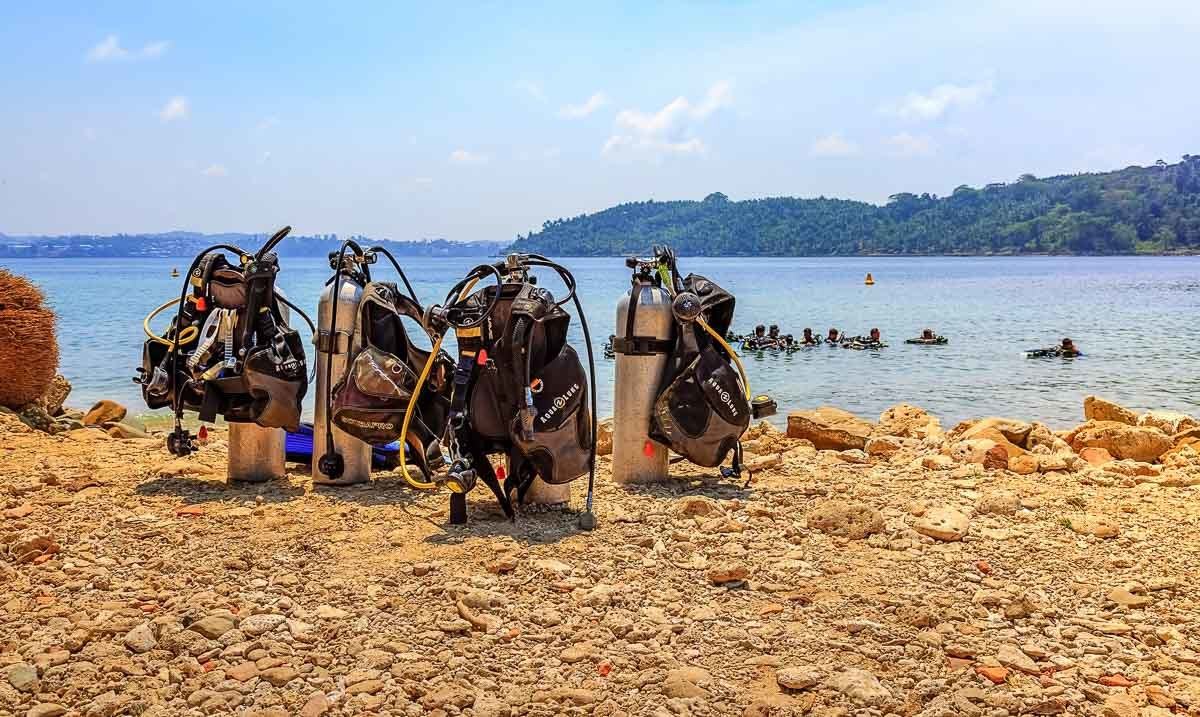Some of our links are affiliated, we will earn a commission when you buy a service or product. This will have no extra cost for you. For further info please refer to our Privacy Policy
I got my PADI Open Water Certification in the Andaman Islands, and here is everything that happened (the amazing and the not so good), plus all the information you need to go scuba diving in Andaman Islands in India.
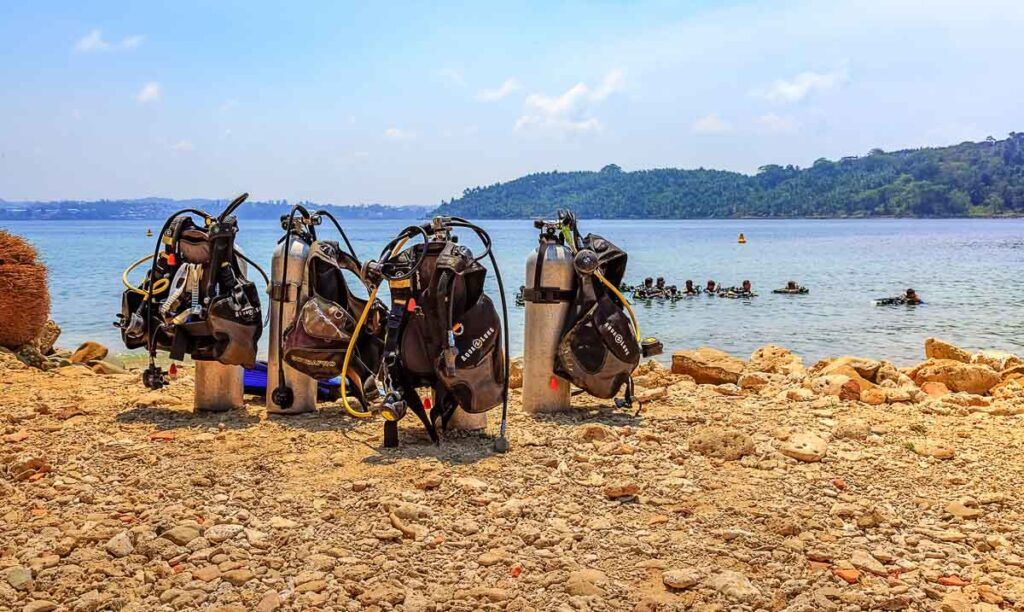
The Andaman Sea is a well-known scuba diving spot in the world and one of the best scuba diving sites in India. After trying a fun dive in Vietnam one summer, I was keen to be a certified diver and do the PADI Open Water Certification to begin with.
Another friend, Aanchal, quickly agreed to join me in this diving adventure, and we did some research on where to do the scuba diving course in the Andaman Islands. We wanted something not too expensive and after exploring options to dive in Thailand and Lakshadweep, we chose to learn scuba diving in Havelock Andaman island.
And here is how it went!
Scuba diving in the Andaman Islands
First of all, let’s share some basic information about the Andaman Islands and why people choose to scuba dive here.
Andaman & Nicobar Islands are located on the Bay of Bengal, while politically a part of India, feel anything like that. In fact, the islands on the eastern side of the archipelago are closer to Thailand than to the Indian mainland.
There are in total 572 Adanam Islands, each one of them with stunning nature, from sandy beaches to turquoise water and lush green vegetation.
But why did Andaman Islands diving spots become famous?
Colorful coral reefs, interesting underwater topography, shipwrecks, and diverse marine life are reasons enough to face the long travel journey to Havelock and other Andaman islands.
Another positive point is the variety of Andaman Island diving spots, for beginners to experienced divers.
More about the Adaman dive sites, its marine life, when to go diving in the Andaman Islands, and other practical info you can find later on in the guide.
Now I want to share my first-hand experience, so you can feel if diving paradise is the type of underwater experience you are looking for.

My experience scuba diving in Andaman Islands
Before learning how to dive or practicing your already known skills, you need to plan your trip to the Andaman islands. And this might be your first challenge.
Depending on where you come from and how long your traveling journey will be, I would say to add an extra day before beginning your diving course. Get a good rest, see a bit of the island, and then you are ready to dive.
Reaching Havelock island
Havelock, aka Swaraj Dweep, is only accessible by sea. You will need to fly to Veer Savarkar International Airport in Port Blair and from there take a public ferry or a private boat.
It takes the good part of a day to reach Havelock Island from Delhi, whether you take the flight via Chennai or Calcutta.
Our flight via Calcutta made it in time to reach the dock to take the 1:45 pm private catamaran. I had arranged the transfers from the airport to the dock and the purchase of ferry tickets via our diving school.
You can plan your transportation to Havelock and other islands by yourself – use Skyscanner for searching flights, and Bookaway or 12.Go for searching and buying ferry tickets.
Or you can ask your diving school to plan everything for you, as we did.
The not-so-rough ride from Port Blair to Havelock jetty took about 2 hours. It was raining as we stepped out of the catamaran. A smooth pre-organized transfer and then my friend and I settled into our duplex cottage organized by the diving center.
Our accommodation was made of a neat living room and bathroom on the ground floor and a bedroom and a balcony on the first floor. Great value for money! (more about accommodation on the Andaman Islands later on)
There was nothing much to do that day. We were happy to get in a relaxed frame of mind, walk around the beach, eat at their restaurant, and get in bed early.
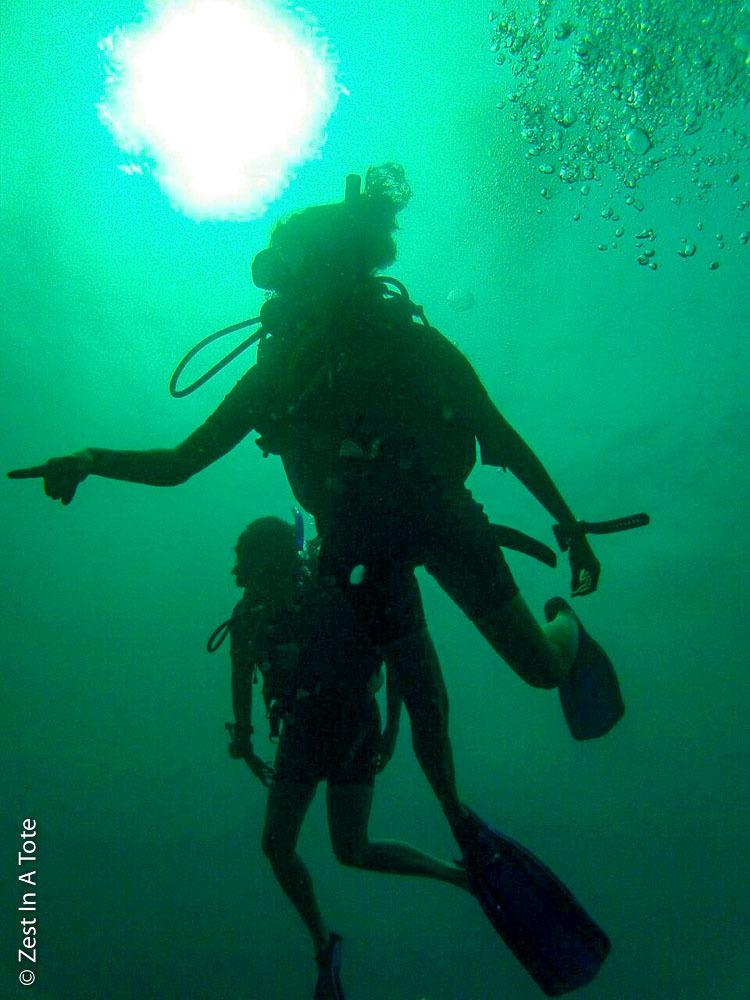
Day 1- Scuba diving course in Andaman Islands
We were to report at 8 am after breakfast to start our Open Water Diving Certification Course.
Having read all the theory earlier in the week, we dived straight into the practical part. We were introduced to one of the senior dive instructors at the center and the first task was assembling the gear – BCD, cylinders, regulators, and whatnot.
Our instructor turned out to be a perfectionist. He made us assemble and disassemble the gear 4 times before he was fully satisfied.
Diving skills practice
We were to wear the gear and go to the beach for our swim test – 10 minutes of float on the back and 200 meters of swim without fins / 300 meters with fins.
After the swim and float test, we went to the shallow part of a beach for some skills practice. This involved taking the regulator underwater and putting it back in the mouth, purging the water from the regulator, switching between snorkel and regulator, clearing a partially flooded mask off the water, etc.
Bear in mind that this routine might be different depending on the diving course you are doing and your diving skill levels.
We got a short break and had bananas and lunch on the boat.
I was really tired by now. Lack of sleep, exercise that my body was not used to, the information overload, all put together exhausted me. Some rest and more skills practice in the water – experiencing ‘’out of air’’ when the instructor shuts the air supply, breathing with your buddy’s alternate air regulator.
First open-water dive in Andaman Islands
And then on to our first Open Water Dive to Nemo Reef – not too deep at about 9 meters.
I just didn’t realize how tired I was before the start of this. After a few minutes of moving underwater my friend and I were struggling with being horizontal at a particular level.
First-time divers should remember not to fret too much about buoyancy control. There was a dramatic improvement for us in the next 2 days.
The Andaman Sea is alive and how amazing it is! In just a few minutes, we saw anemone/clownfish, pipefish, parrotfish, sea cucumber, bannerfish, and a scorpionfish (that had camouflaged itself on a rock, poisonous).
Then the instructor found a safe spot on the sand, checked for creatures, asked us to kneel and do some skills practice that we were taught earlier in the shallow water. My instructor asked me to lose my air regulator, find it, and put it back in my mouth.
I tried once in haste – got the regulator from under my arm instead of over it, and tried to take it out of my mouth again. But while putting it back, I just didn’t lock my lips over it, swallowed water, and panicked when I couldn’t purge the water and breathe air.
Instead of thinking calmly about my alternate options – breathing from my alternate air source, taking the alternate from my buddy/instructor, I broke the basic rule in scuba – stopped breathing, gulped in water, panicked and kicked up to get out.
My instructor tried to put the regulator in my mouth to do some damage control but I just wanted out. On surfacing, he asked the other divemaster to take me on the boat and went down to continue the dive with my friend.
I was so dejected that evening but just wanted a hot shower, food, and sleep to get over with that disaster.
That’s why I told you planning a good night/day of rest before your dive experience is a smart decision.
Day 2 – Scuba diving in Andaman islands
More skills practice and a second open water dive.
I was both dreading and looking forward to the next day. We reported at 7:30 am post breakfast at the dive center restaurant.
Our gear had already been assembled and taken to the dive boat. My friend was asked to stay out on the boat and our instructor asked me to go for the Open Dive 1 with him and redo the skill practice session that was left incomplete the day before.
And after a good night’s rest, it thankfully turned out to be easy. I removed my mask and put it back. I removed my regulator, kept breathing out, retrieved it and put it back all quite easily. I enjoyed the rest of the dive and got a big smile from him when we surfaced.
We did a lot of new skills practice on the second day of the course – manually inflating the BCD, ‘sipping’ air from a malfunctioning regulator, etc. This was followed by bananas and a long rest in the boat, followed by another training dive.
We were back at the Dive Center by 1 pm. More than enough time to take a shower and decide to step out and explore the island.
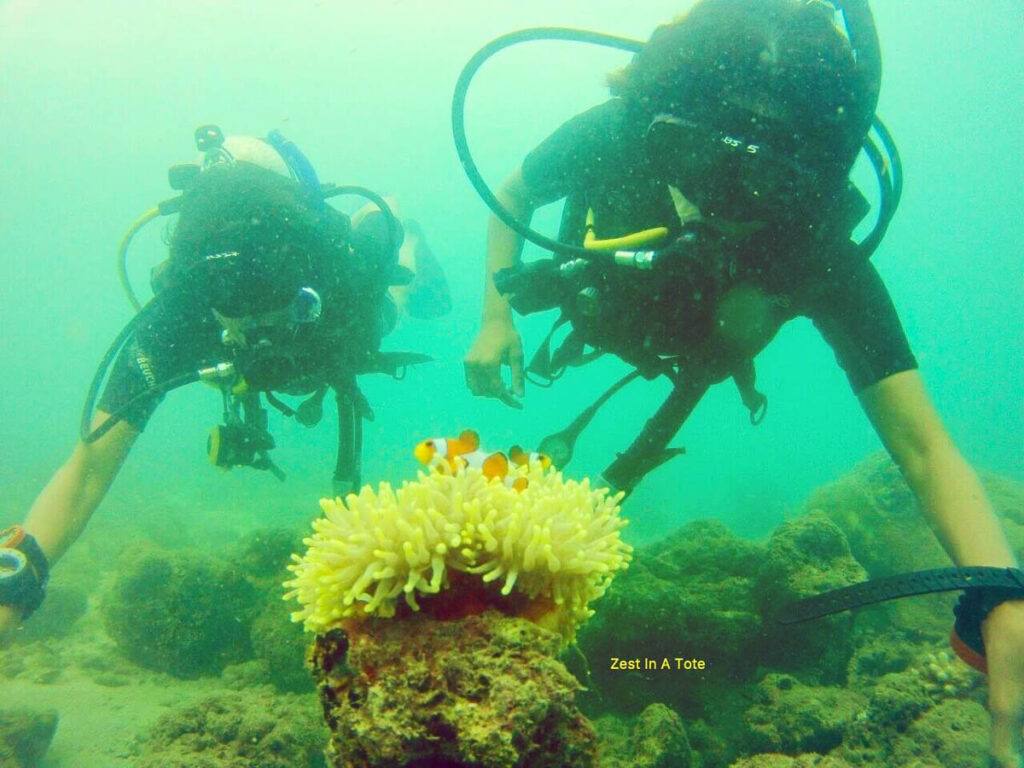
Day 3 – More dives and our first rough experience
Our third dive was at the Red Lighthouse site within the harbor. We were hoping to go outside the harbor to a dive site named The Wall, but the meteorological department didn’t give permission on account of a cyclone warning.
Open water dive 3
Red Lighthouse is a shallow site – max water depth of about 10 meters – and is beautiful. Underwater visibility on the third day was much better than the past 2 days, at about 10 meters or more.
We put on all our diving gear on the boat, did the basic safety check and got off the boat using the giant stride exit.
As we descended, I looked up at the school of colorful fish moving all around and felt the magic of diving come alive for me. We were much more confident with managing our buoyancy today.
One of the attractions at this site apart from underwater life is a Kinetic Honda scooter. This stood intact on the sea bed, providing a home to some corals and tiny fish.
We also spotted huge barrel sponges – some over 4 meters and an octopus resting on a rock with its tentacles all folded inside. The dive master made us do some skills practice at this depth during the dive.
We surfaced up feeling quite exhilarated with our first 60 minute dive! But underwater peace and quiet don’t give away the turbulence on the surface. It was drizzling when we came up.
Open water dive 4 and a lengthy exam
An hour’s chit-chat later, the weather had steadily worsened. We decided to go back in for the fourth and last training dive.
This was a completely different experience than the morning dive; visibility was barely 2/3 meters. I could just about make out Manish and Aanchal’s shapes and decided to stay close to them.
A key new skill that had to be learned was navigation basics. We were made to look into a compass, go out in one direction for just 10 kicks, and come back to the same point.
For some reason, while concentrating on the compass, I was breathing out less than all the deep breaths going in. Consequently, unknown to me, instead of going horizontally, I kept moving up and up.
Of course, when I came up, I was way above the dive instructor instead of my starting point! My friend made the same mistake. Many threats and scolding later (He wrote ‘U WILL FAIL’ on the slate he was carrying with him!), we did another practice run and got the hang of it. Phew!
Talking about underwater wonders, nothing except a large sea fan was seen during the dive. And the water was really choppy when we surfaced. But my friend felt that training during this condition is a good experience to have under your belt. I couldn’t agree more.
We went back to the dive center, and after a hot shower and lunch, sat down to give a lengthy exam. With this final hurdle out of the way, Aanchal and I got our diver certifications!!
Day 4 – Havelock, Andaman Islands Fun Dives
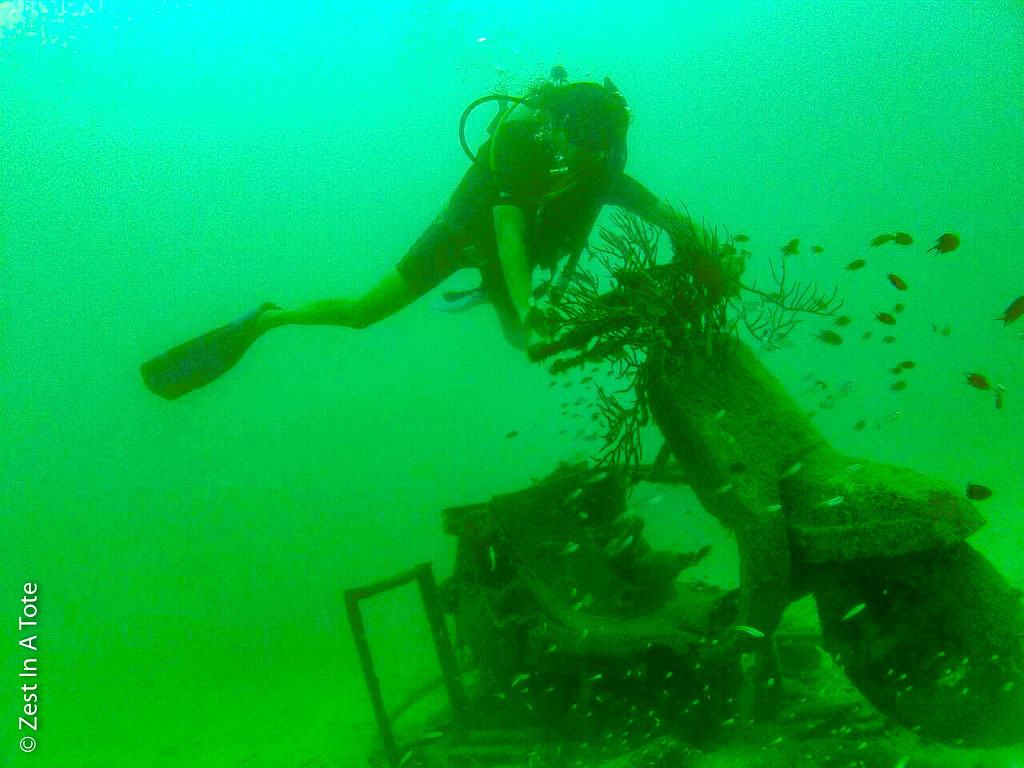
The meteorological department repeated its cyclone warning and didn’t give the boat passengers permission to go outside the harbor. So our first dive as PADI-certified divers was again at the Pilot Reef, this time with another divemaster.
Dive at Pilot Reef
A leopard shark had been spotted at this site a day earlier and we were hopeful. Our first part of the dive went in searching for this shark, but no luck.
The reef does have some good marine life to watch – giant groupers, flute mouthed fish, juvenile moray, striped fusilier, lionfish, angelfish, sea cushion star and more. All in all, a great dive.
Dive at Red Lighthouse
The second dive of the day was at the Red Lighthouse. The agenda of the dive apart from seeing all the other aquatic life was to specifically spot stingrays.
And what a thrill when our divemaster pointed to a Kuhl’s stingray. It is an indescribable thrill to see a creature in its natural setting.
I spotted a lionfish hiding inside a rock crevice and another stingray. I got so excited and was flailing my hands and feet to get my companions’ attention. We also saw giant clams, emperor angelfish, lionfish, mustache triggerfish, porcupine fish, and groupers.
Despite not being able to go to the more famed spots (list below), we were glad to experience these dives as newly certified divers. Soon it was time to bid goodbye to the well-trained crew at Barefoot Dive Center.
The 2-hour ride back on the catamaran started out pleasant but soon became a wish-this-would-end-soon nightmare.
Once the catamaran got out in the open rough sea, a lot of people got seasick. And even though I am quite okay on choppy waters, the smell of vomit from several areas in the closed, air-conditioned cabin made me gag.
Diving on a remote island is not only beautiful underwater landscapes and a variety of fishes, but when the weather changes, things get rough.
Finally, we landed at Port Blair and checked into our room at the Fortune Bay Hotel. We opened a bottle of wine and enjoyed that with heavy greasy Indian food!
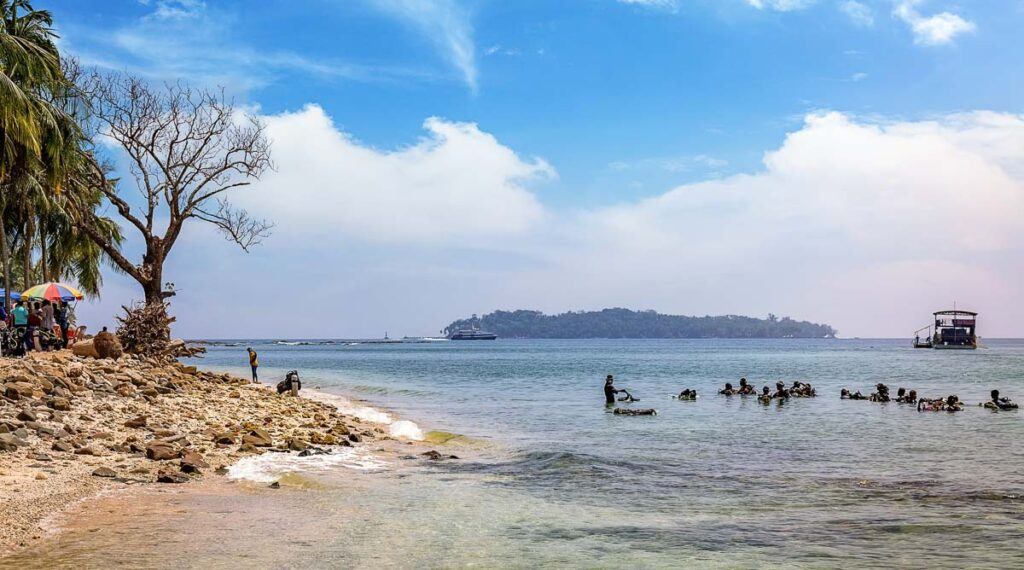
Questions people ask me about diving in Andaman Islands:
When to go diving in the Andaman Islands?
One of the main questions is about perfect weather. Well, diving is certainly better when visibility is high, which in turn depends on wind, ocean floor, and weather conditions to name a few.
Professional Association of Diving Instructors (PADI) says that the Andaman Islands diving season is from October/November to May.
During this period you can expect almost no rain, so the visibility of the water is good and the boat rides are more comfortable.
The water temperature is around 27º to 29ºC (80-84ºF).
It’s a good time for beginners who want to try fun dives or discover scuba diving in the calm waters.

Where to go diving at Andaman Islands?
Havelock Island and Neil Island (aka Shaheed Dweep) are the most famous islands and good places for beginners and experienced divers. They have many diving spots, and if you are lucky with the weather, you can visit many of them in a couple of days/dives.
These two islands offer good infrastructure with hotels and diving centers, and from here you can also do day trips to other diving destinations.
But to give you an overall idea of how diving is in the Andaman Islands in India, I researched all the islands you can dive, and where to dive in each of them. Thank me later!
Best diving sites in the Andaman by island
Havelock Island Diving Sites
All my scuba diving sessions happened here, the clarity of the water, the marine biodiversity, and the vibrant fishes made it the perfect dive spot.
- Nemo Reef
- Barracuda City
- Seduction Point
- Aquarium
- Turtle Bay
- Mac Point
- Lighthouse
- The Wall
- Pilot Reef
- Minvera Ledge
- Johnny’s Gorge
- Whitehouse Rock
- Dicksons Pinnacle
- Jackson’s Bar
- Broken Ledge
- S.S. Inchkett
- M4
- Red Pillar
- The Slope
- MV Mars
- Purple Haze
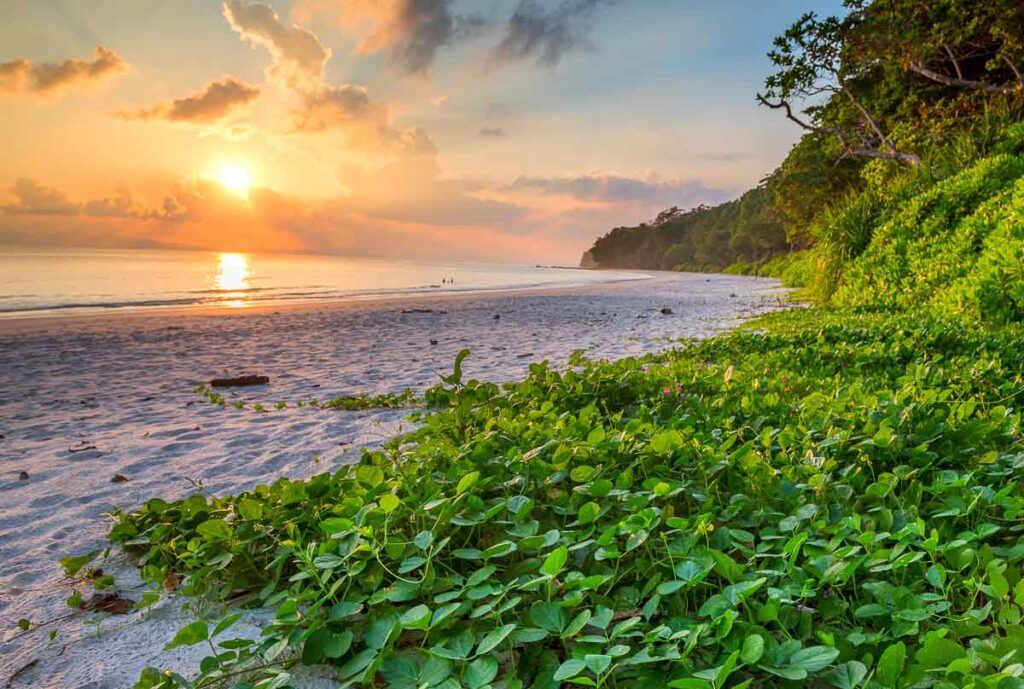
Neil Island Diving Sites
Underwater life is rich here, but the water might not be so clear. It’s an island famous for its hotels and resorts, perfect if you want to combine diving and relaxation. Neil Island popular dive sites are:
- Busy Burro
- Rocky’s
- Margerita
- Junction
- Manta Point/Robin’s Bay
- Nursery/ One Bottle
- Bus Stop
- Aquarium/ Neil Garden
- Lighthouse
North Bay Island
North Bay is located near Ross Island and Port Blair. It’s small compared to the other two islands we talked about, but the blue waters and the population of corals here are impressive.
The island has a coral belt protected by the Andaman administration and because of that diving and water sports activities spots change often.
Diving usually happens beyond the shallow waters and keep in mind that here you can face moderate underwater currents. The good thing is that you can spot different marine species.
One thing to notice, the costs of scuba diving courses or sessions here are low compared to other Andaman islands. But don’t forget to add the additional transportation costs while calculating the budget for your trip.
And, when it comes to choosing dive resorts, dive centers, and instructors, price should not be your first concern.
Port Blair
Por Blair is usually our point of arrival at the Andaman Islands but if you don’t want to travel further, you can dive here.
The city is the capital of the Andaman Islands, so it offers a lot to do and see above and underwater. Diving prices in Port Blair are not on the cheap side, but considering that you don’t need to add the ferry trip to your costs, it might be a good option.
It’s also a good place if you are short on time and want to do the 3-day diving course without the extra day for traveling. further to the islands.
Port Blais diving sites are:
- Corbyn’s Cove Beach
- Snake Islands
- Mahatma Gandhi Marine National Park.
- Corruption Rock
- Rutland Island
- Snake Island
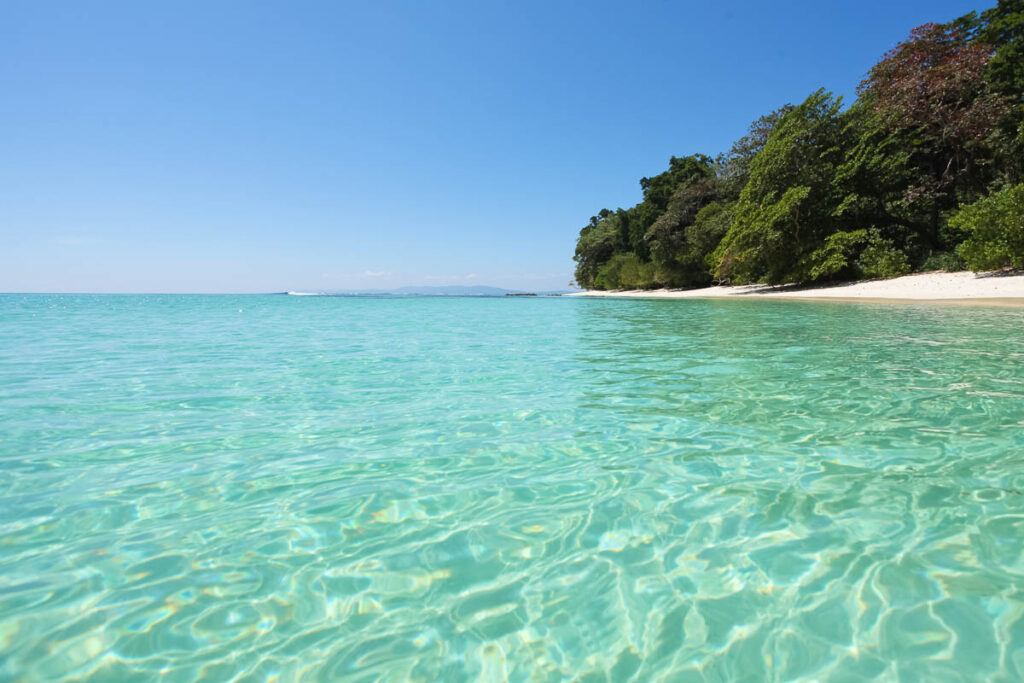
Barren Island
Diving in Barren Island is a once-in-a-lifetime experience. This beautiful island is close to tourists because it’s the home of an active volcano. Far from almost everything, it’s a paradise for divers because of its preserved and untouched nature.
On a perfect diving experience, you can spot dolphins, white tip reef sharks, turtles, manta rays, silver garden eels, barracuda, and colorful reefs.
Diving in Barren Island consists of taking a 12-hour or so boat ride. It is usually planned as a day trip, where you can do 3 dives in different spots near the island. And because of the distance, you can already imagine it’s a great and more expensive diving adventure.
How to choose the best dive center or resort?
First of all, you need to do your research. Read what the schools and dive operators offer, compare reviews, send emails with your doubts, and compare prices to plan your travel expenses.
We did our diving course with Barefoot Dive Center, and we are very happy with it.
What type of diving certification can you get?
More than getting your first diving certification, diving schools in the Andaman Islands can offer different SSI and PADI programs. Most of the diving centers and resorts can help you get your PADI Advanced Open Water, any other advanced diving courses, or PADI speciality courses such as PADI Rescue.
Just keep in mind that depending on what course or scuba diving experience you want to have, you have to plan your days on the islands accordingly.
How much does it cost to dive in the Andaman Islands?
All the topics we covered above will impact the diving costs, so I can tell you exactly the prices or how much you expect to spend.
Keep in mind that you can plan a budget trip by sharing accommodation, using public ferries instead of private transfers, and also keep low on your food expenses.
On the other hand, if you are not worried about money, you can treat yourself really well on the islands.
Do I need to be a good swimmer?
One question that friends and acquaintances have repeatedly asked me after the course is whether I am a strong swimmer, whether I know how to swim underwater etc.
You have to know how to swim for sure. Apart from being an international regulation for a dive course, it wouldn’t be wise to dive without knowing how to swim even if some unscrupulous dive center were to take you.
Most accidents apparently happen on the surface and you would panic in the sea if you didn’t know how to swim. But you don’t have to be an incredible swimmer, just an average one.
I don’t swim underwater but the instructor did teach us how to dive under with a snorkel, touch the sea bed (at about 5 meters depth I think), and come up and clear the snorkel pipe off the water.
Travel Advice:
Don’t forget your Travel Insurance! You don’t want anything to ruin your trip, right? So don’t take the risk! Reliable travel insurance can help you in case of travel issues, from accidents to health problems, travel delays, and lost luggage.
There are many insurances in the market, our picks are HeyMondo and SafetyWing. We used both and always had a good experience. Click on the insurance names to get a quote.
Anyone can dive in the Andaman Islands?
Sadly not! It’s not only about knowing how to swim, before diving you need to take into consideration the age limit and your medical conditions.
The Andaman Islands Diving Guideline says that people over 60 years old, children below 6, and pregnant women can’t dive. All the details of the guidelines including the maximum depth limit for scuba diving, you can get with the scuba dive center.
More tips on Scuba Diving in the Andaman islands
First of all, during peak season (the best time for scuba diving), book your accommodation on Havelock or Neil Islands in advance. It is also true for Port Blair and all the ferries or catamarans you will need to take.
Where to stay and best resorts for scuba diving in Andaman Islands

Hotels on Havelock Island
(click on the hotel name for photos and rates)

Hotels on Neil Island
(click on the hotel name for photos and rates)

Hotels in Port Blair
(click on the hotel name for photos and rates)
What to do in the Andaman Islands beyond diving?
Well, after seeing incredible coral gardens and a wide variety of fishes, stay a little bit on the shore and enjoy the beautiful beaches of the islands.
Here are a few unmissable beaches:
- Radhanagar Beach (Havelock)
- Elephant Beach (Havelock)
- Kalapathar Beach (Havelock)
- Bharatpur Beach (Neil Island)
- Laxmanpur Beach (Neil Island)
That’s a wrap! I hope I helped you understand more about how to travel to the Andaman Islands for diving, and also inspired you to live this memorable experience.
Author: Shweta Singhal
Shweta has always been passionate about travel and immersing in new experiences. Having been to over 45 countries, she blogs at Zest In A Tote to bring family-friendly itineraries and tips, destinations, and luxury stays to her readers. Her belief in family travel needn’t be boring and one can do a mix of local culture & food, adventure activities and relaxation, all with family.

